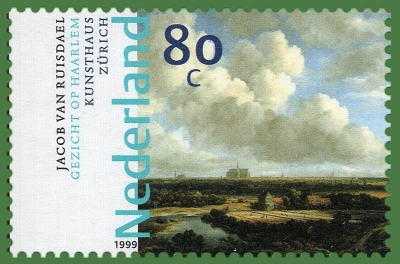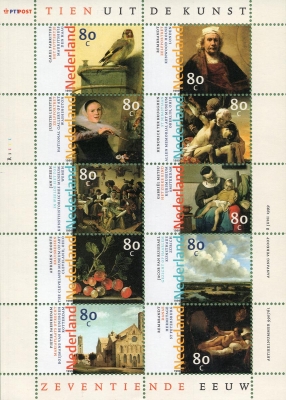-
Dutch 17th century paintings
Netherlands 1999.06.08
In issue: Stamp(s): 10 Sheet(s): 1
Printing: offset
Issued in: sheets of 10 (2*5) stamps by one series
-
Number by catalogue: Michel: 1727 Yvert: 1700 Scott: 1029h Gibbons: 1953
Perforation: Comb Perforation type: 13 ¼x12 ¾
Subject:
80 cents.
Reproduction of painting by Jacob van Ruisdael - "View of Haarlem with bleaching fields"
Additional:
*Jacob Isaackszoon van Ruisdael (c. 1629 - 1682, Haarlem) was a Dutch painter, draughtsman, and etcher. He is generally considered the pre-eminent landscape painter of the Dutch Golden Age, a period of great wealth and cultural achievement when Dutch painting became highly popular.
Prolific and versatile, Ruisdael depicted a wide variety of landscape subjects. From 1646 he painted Dutch countryside scenes of remarkable quality for a young man. After a trip to Germany in 1650, his landscapes took on a more heroic character. In his late work, conducted when he lived and worked in Amsterdam, he added city panoramas and seascapes to his regular repertoire. In these, the sky often took up two-thirds of the canvas. In total he produced more than 150 Scandinavian views featuring waterfalls.
Ruisdael's work was in demand in the Dutch Republic during his lifetime. Today it is spread across private and institutional collections around the world; the National Gallery in London, the Rijksmuseum in Amsterdam, and the Hermitage Museum in St. Petersburg hold the largest collections. Ruisdael shaped landscape painting traditions worldwide, from the English Romantics to the Barbizon school in France, and the Hudson River School in the US, and influenced generations of Dutch landscape artists.
**Until the beginning of the 19th century, while traveling through the European suburbs, one could see huge green meadows completely covered with fabrics. A similar landscape is captured on the stamp.
Textile workers of that time were forced to leave linen products under the scorching sun for a long time - this was the only way to achieve a snow-white shade.
__________
Small details, in particular - 9 windmills, cannot be discerned on the stamp. You can see them in the pictures below.



